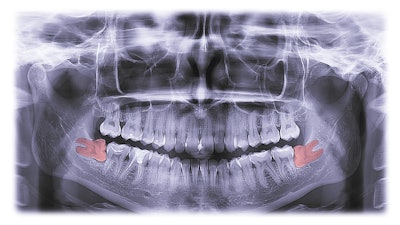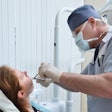
Orthodontists may be more likely to support early extraction of third molars to prevent crowding and cavities, while oral surgeons focus on avoiding pericoronitis and infections. This study was recently published in BMC Oral Health.
Furthermore, women were more likely than men to prefer extraction of partially impacted third molars to prevent cavities on second molars, which could be relevant in gender medicine, the authors wrote.
"This study has been enlightening for departments to consult each other before the extraction of a patient's asymptomatic third molar" wrote the authors, led by Ipek Necla Guldiken of Istinye University in Turkey (BMC Oral Health, September 11, 2024, Vol. 24, 1072).
The cross-sectional study used a web-based questionnaire to collect data from 127 participants (51.2% female, 48.8% male). The participants were evenly split between oral surgeons (49.6%) and orthodontists (50.4%), as well as trainees and specialists. Descriptive statistics were used to analyze the data.
Orthodontists and oral surgeons differed in their reasons for extracting partially impacted molars. Orthodontists focused on preventing late dental crowding, while oral surgeons prioritized risks like pregnancy symptoms and infection (p < 0.05). Both groups agreed on extracting fully impacted molars for certain risks, except for focal infection, where oral surgeons were more concerned (p < 0.05), according to the results.
Additionally, both men and women favored extracting partially impacted third molars over fully impacted ones. This preference was consistent across all age groups (p < 0.05). However, women more frequently saw cavities in the adjacent molar as a reason for extraction, but gender differences were not significant for other risks like late dental crowding, infection, or pregnancy-related symptoms. Men were more likely than women to consider periodontal disease and cavities as reasons to extract fully impacted molars (p < 0.05).
However, the study had limitations. This study only included orthodontists and oral surgeons from a single country. Future international studies with a broader participant base are needed, the authors noted.
"This divergence between the participants may inform the guidelines for prophylactic management of third molars," Guldiken and colleagues concluded.


.I3dcZKubTl.png?crop=focalpoint&fit=crop&fp-x=0.5&fp-y=0.5&h=100&w=100&auto=format%2Ccompress&q=70)




.I3dcZKubTl.png?crop=focalpoint&fit=crop&fp-x=0.5&fp-y=0.5&h=167&w=250&auto=format%2Ccompress&q=70)











